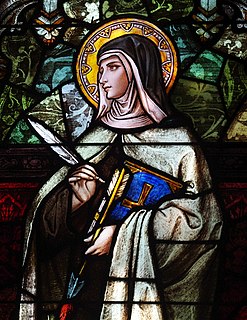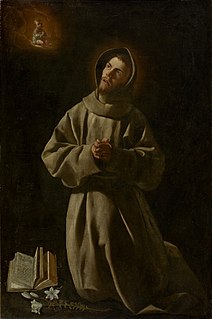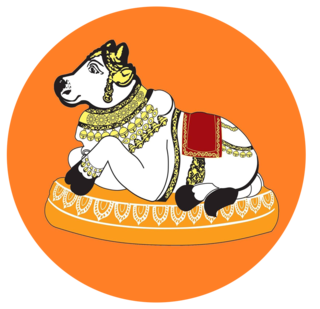Related Research Articles

The Book of Mormon is a sacred text of the Latter Day Saint movement, which adherents believe contains writings of ancient prophets who lived on the American continent from approximately 2200 BC to AD 421. It was first published in March 1830 by Joseph Smith as The Book of Mormon: An Account Written by the Hand of Mormon upon Plates Taken from the Plates of Nephi.

Saint Columba was an Irish abbot and missionary Evangelist credited with spreading Christianity in what is today Scotland at the start of the Hiberno-Scottish mission. He founded the important abbey on Iona, which became a dominant religious and political institution in the region for centuries. He is the Patron Saint of Derry. He was highly regarded by both the Gaels of Dál Riata and the Picts, and is remembered today as a Catholic saint and one of the Twelve Apostles of Ireland. In Ireland, he is commonly known as Colmcille

Saint Francis of Assisi, born Giovanni di Pietro di Bernardone, informally named as Francesco, was an Italian Catholic friar, deacon and preacher. He founded the men's Order of Friars Minor, the women's Order of Saint Clare, the Third Order of Saint Francis and the Custody of the Holy Land. Francis is one of the most venerated religious figures in history.

Mormonism is the predominant religious tradition of the Latter Day Saint movement of Restorationist Christianity started by Joseph Smith in Western New York in the 1820s and 30s.

A saint is a person who is recognized as having an exceptional degree of holiness or likeness or closeness to God. However, the use of the term "saint" depends on the context and denomination. In Roman Catholic, Eastern Orthodox, Anglican, Oriental Orthodox, and Lutheran doctrine, all of their faithful deceased in Heaven are considered to be saints, but some are considered worthy of greater honor or emulation; official ecclesiastical recognition, and consequently veneration, is given to some saints through the process of canonization in the Catholic Church or glorification in the Eastern Orthodox Church.

Saint George was a soldier of Cappadocian Greek origins, member of the Praetorian Guard for Roman emperor Diocletian, who was sentenced to death for refusing to recant his Christian faith. He became one of the most venerated saints and megalo-martyrs in Christianity, and he has been especially venerated as a military saint since the Crusades.

John the Apostle was one of the Twelve Apostles of Jesus according to the New Testament. Generally listed as the youngest apostle, he was the son of Zebedee and Salome or Joanna. His brother was James, who was another of the Twelve Apostles. The Church Fathers identify him as John the Evangelist, John of Patmos, John the Elder and the Beloved Disciple, and testify that he outlived the remaining apostles and that he was the only one to die of natural causes. The traditions of most Christian denominations have held that John the Apostle is the author of several books of the New Testament, although this has been disputed by scholars.

Saint Nicholas of Myra, also known as Nicholas of Bari, was an early Christian bishop of the ancient Greek maritime city of Myra in Asia Minor during the time of the Roman Empire. Because of the many miracles attributed to his intercession, he is also known as Nicholas the Wonderworker. Saint Nicholas is the patron saint of sailors, merchants, archers, repentant thieves, prostitutes, children, brewers, pawnbrokers, and students in various cities and countries around Europe. His reputation evolved among the faithful, as was common for early Christian saints, and his legendary habit of secret gift-giving gave rise to the traditional model of Santa Claus through Sinterklaas.
The Little Prince is a novella by French aristocrat, writer, and aviator Antoine de Saint-Exupéry. It was first published in English and French in the US by Reynal & Hitchcock in April 1943, and posthumously in France following the liberation of France as Saint-Exupéry's works had been banned by the Vichy Regime. The story follows a young prince who visits various planets in space, including Earth, and addresses themes of loneliness, friendship, love, and loss. Despite its style as a children's book, The Little Prince makes several observations about life and human nature.

Saint Anthony of Padua, born Fernando Martins de Bulhões – also known as Saint Anthony of Lisbon – was a Portuguese Catholic priest and friar of the Franciscan Order. He was born and raised by a wealthy family in Lisbon, Portugal, and died in Padua, Italy. Noted by his contemporaries for his powerful preaching, expert knowledge of scripture, and undying love and devotion to the poor and the sick, he was one of the most quickly canonized saints in church history. He was proclaimed a Doctor of the Church on 16 January 1946. He is also the patron saint of lost things.

James the Great also known as James, son of Zebedee or as Saint James the Greater was one of the Twelve Apostles of Jesus according to the New Testament. James is described as one of the first disciples to join Jesus. The Synoptic Gospels says that James and John were with their father by the seashore when Jesus called them to follow him. Saint James is the patron saint of Spain and, according to tradition, his remains are held in Santiago de Compostela in Galicia.

Raphael is an archangel responsible for healing in the traditions of most Abrahamic religions. Not all branches of these religions consider the identification of Raphael to be canonical.

Michael is an archangel in Judaism, Christianity, and Islam. In Roman Catholic, Eastern Orthodox, Anglican, and Lutheran systems of faith, he is called "Saint Michael the Archangel" and "Saint Michael". In the Oriental Orthodox and Eastern Orthodox religions, he is called "Saint Michael the Taxiarch". In other Protestant churches, he is simply called "Archangel Michael".

Saint Brendan of Clonfert, also referred to as "Brendan moccu Altae", called "the Navigator", "the Voyager", "the Anchorite", and "the Bold", is one of the early Irish monastic saints and one of the Twelve Apostles of Ireland. He is primarily renowned for his legendary quest to the "Isle of the Blessed", also denominated "Saint Brendan's Island". The Navigatio Sancti Brendani Abbatis can be described as an immram, i. e., Irish navigational narrative.

The Latter Day Saint movement is the collection of independent church groups that trace their origins to a Christian Restorationist movement founded by Joseph Smith in the late 1820s.

The Church of Christ was the original name of the Latter Day Saint church founded by Joseph Smith. Organized informally in 1829 in New York and then formally on April 6, 1830, it was the first organization to implement the principles found in Smith's newly published Book of Mormon, and thus represents the formal beginning of the Latter Day Saint movement. Later names for this organization included the Church of the Latter Day Saints, the Church of Jesus Christ, the Church of God, the Church of Christ of Latter Day Saints, and the Church of Jesus Christ of Latter Day Saints.

The Nayanmars were a group of 63 saints in the 6th to 8th century who were devoted to the Hindu god Shiva in Tamil Nadu. They, along with the Alwars, their contemporaries who were devoted to Vishnu, influenced the Bhakti movement in Tamil. The names of the Nayanars were first compiled by Sundarar. The list was expanded by Nambiyandar Nambi during his compilation of material by the poets for the Tirumurai collection, and would include Sundarar himself and Sundarar's parents.

All Saints' Day, also known as All Hallows' Day, Hallowmas, the Feast of All Saints, or Solemnity of All Saints, is a Christian festival celebrated in honour of all the saints, known and unknown. In Western Christianity, it is celebrated on November the 1st by the Roman Catholic Church, the Anglican Communion, the Methodist Church, the Church of the Nazarene, the Lutheran Church, the Reformed Church, and other Protestant churches, November 1st is also the day before All Souls Day. The Eastern Orthodox Church and associated Eastern Catholic Churches and Byzantine Lutheran Churches celebrate it on the first Sunday after Pentecost. Oriental Orthodox churches of Chaldea and associated Eastern Catholic churches celebrate All Saints' Day on the first Friday after Easter.